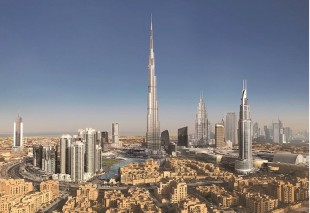

How the Middle East's top tourism markets performed in 2017

In 2017, Dubai saw the highest revenue per available room (RevPAR) of US $189 and the highest occupancy rate (77.7%) in the Middle East, according to a new EY report.
Research by EY showed also showed that hotels in Jeddah registered the second best RevPAR of $170 while Abu Dhabi following closely on occupancy at 77.1%.
EY also revealed that the highest room rates of the year were recorded in Saudi Arabia, with an average daily rate of $300 in Makkah and Jeddah averaging at $266.
The Middle East Hotel Benchmark Survey Report, produced by EY, provides a monthly and year-to-date performance overview of leading hotels in the Middle East.
It said in the UAE, the hospitality market experienced a dip in RevPAR performance in 2017 compared to 2016, with Dubai and Abu Dhabi experiencing a drop of 6.2% and 2.6% respectively. Ras Al Khaimah however, witnessed an increase of 1.9% compared to 2016.
Abu Dhabi saw a 2.2% increase in occupancy to 77.1% in 2017, which may be attributed to events such as the Abu Dhabi Food Festival and the New Year’s Countdown Village. However, the average room rate in the UAE capital experienced a decrease by 5.3% to $120 in 2017.
In the Dubai hospitality market, there was a decline in occupancy to 77.7%, down from 79.1% in 2016. There was also a decrease in average room rates by 4.4% to $243 in 2017.
Ras Al Khaimah witnessed an increase in occupancy by 2.5% compared to 2016. However, the average room rates decreased by 1.5% to $158 in 2017.
Yousef Wahbah, MENA Real Estate, Hospitality and Construction Sector leader, said: “The MENA hospitality sector may have seen marginal growth in 2017, but the announcement of several new hotels, government initiatives and the development of several mega projects will help drive tourism in 2018.
“In the UAE, the growth in hospitality supply will be sustained by an increase in occupancy through demand from existing markets and new source markets. Government initiatives such as the expansion of the visa on arrival status to Russian, Chinese, and Indian citizens will help increase visitor numbers and support the diverse hospitality offerings coming to market not only in Dubai and Abu Dhabi, but Ras Al Khaimah and Fujairah as well.
“In Saudi Arabia, government initiatives have paved the way for increased leisure tourism from both international and domestic markets. Recent announcements from the Public Investment Fund (PIF) include entertainment venues, theme parks, and large-scale hospitality and leisure destinations that will eventually rival leading resort destinations around the world. In the short term, hospitality demand will be boosted by corporate travelers, tasked with helping deliver some of these mega developments throughout the Kingdom.
“Other countries in the MENA region, such as Bahrain and Egypt, have government-led initiatives to drive tourism in their markets. Bahrain aims to strengthen the development of two-way tourism between GCC countries. Egypt, which saw an increase across all KPIs last year, will benefit from the opening of two airports and continued government efforts to improve bilateral relations.”